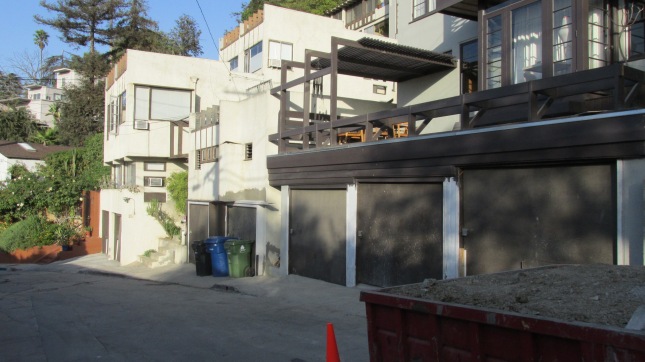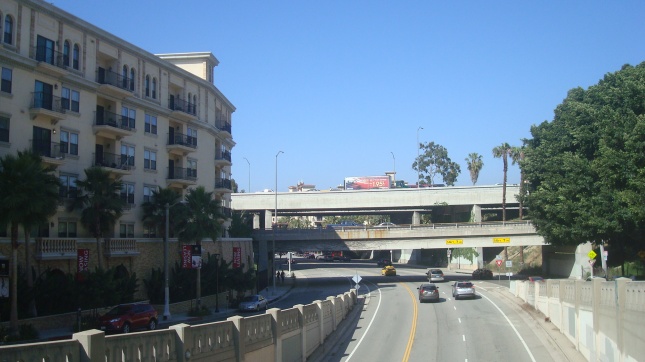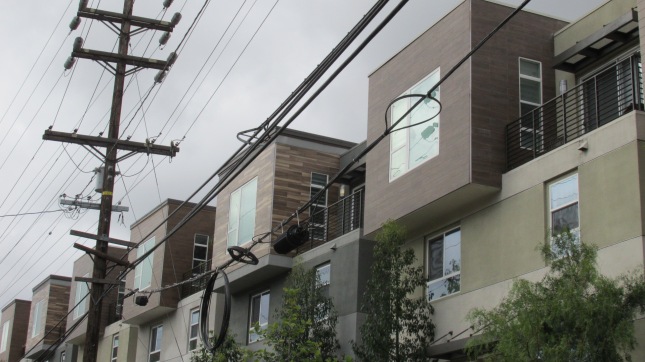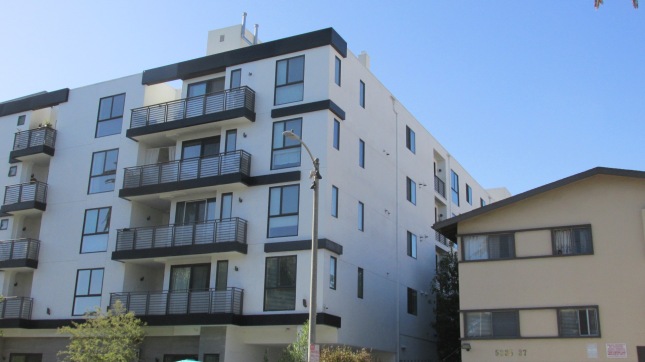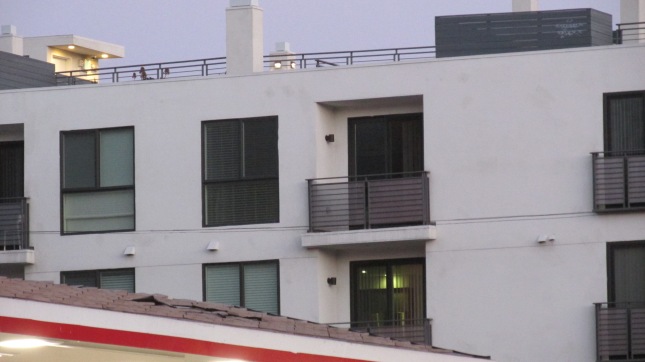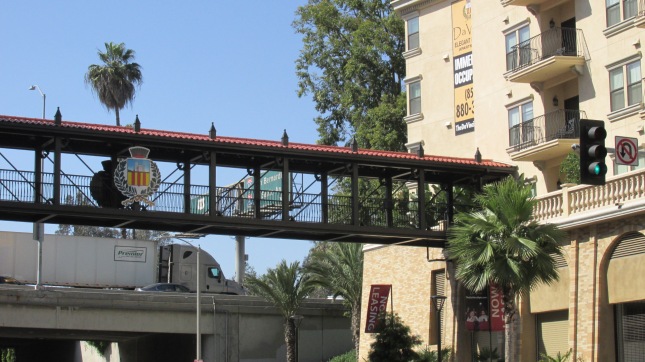
Construction site in the foreground, and Dream Hotel in the background.
If you need any more proof that City Hall is ready to give developers whatever they ask for, there’s a block in the heart of Hollywood you should take a good look at. Hollywood International Regional Center (HIRC), a developer that specializes in hotels funded with EB 5 money, has spent years remaking the stretch of Selma between Cahuenga and Wilcox, and they’re not done yet. Richard Heyman, HIRC Managing Partner, filed his first application for this site about ten years ago, and since then he and his associates have come back asking for numerous changes to their project/s. A review of the associated documents seems to show that the Department of City Planning (DCP) has been more than willing to accommodate the developers’ requests. Construction has been going on almost continuously since 2014, and it looks like it’ll be going on a while longer.
Because tourism is thriving these days, there’s a push to build party hotels in Hollywood. HIRC has already finished one and has a few more in the works. In addition to the completed Dream hotel, there are two other HIRC projects under construction, and the City Planning Commission (CPC) just approved a fourth one. All four of these projects are within a one block radius of Selma and Wilcox. Actually, it almost seems like these four hotels could be considered one big project. But more on that later….
HIRC’s latest effort was on the agenda at the CPC hearing on July 12. This is an eight-story hotel to be built at the corner of Selma and Wilcox. Of course, since this hotel is being built in Hollywood, it has to have a rooftop deck with a pool and a bar/lounge, and even though it wasn’t mentioned in the hearing notice, live entertainment is also part of the package. Given the fact that Hollywood is already jammed with bars, and that crime is rising by double digits, and that area residents are complaining about noise from the party scene, you might ask if we really need another party hotel in Hollywood.
But the folks at the DCP don’t seem bothered by the problems Hollywood residents are facing. They apparently weren’t bothered by the fact that this project was already under construction. Yeah, that’s right. The developer had already started to build this hotel, even though it hadn’t yet been approved. How did that happen? It’s complicated. First we have to ask what the project actually is, and there’s no simple answer. Many Hollywood residents feel HIRC has not been honest about what they’re doing, and that the DCP has been too willing to look the other way. The closer you examine it, the more it appears that this new hotel at Selma and Wilcox is actually part of a complex that’s been in the works for years. But to tell this story, we have to go back to the previous decade….
Heyman’s first hotel on Selma was the Dream 1, which was approved back in 2008. According to the original determination letter, the hotel was going to have a total of 120 rooms, and the project would consist of about 73, 814 square feet with two levels of parking. But then the recession hit, and the project got delayed. In 2011 it was back on again, but this time with a few changes. Now it was going to have 136 guest rooms, but the size held about steady at 73,607 square feet. And while the project was originally required to have 107 parking spaces, now the number was reduced to 90.
So far this doesn’t seem like a big deal. A few more rooms, a little less square footage, and 17 less parking spaces. Who cares? But keep your eye on the parking, because it’s about to disappear.
A Zoning Administrator’s letter dated April 2014 shows further changes. “There will be 182 hotel rooms, 77 on-site parking spaces, 14 off-site parking spaces….” And now, while the height is the same, they’ve added another floor, meaning it’s now a ten story hotel with 79,376 square feet of floor area. Obviously the folks at HIRC are prone to changing their minds, and the folks at the DCP are ready to accommodate them.
But you’re probably saying, “What do you mean the parking disappeared? It’s still there. The ZA approved 77 on-site spaces and 14 off-site spaces. They’ve still got plenty of parking.” And that’s the great thing about misdirection. You were busy looking at the ZA’s letter, instead of keeping your eye on the hotel. Next time you’re in Hollywood, take a stroll down Selma past the Dream.
It has no on-site parking at all.
If you didn’t catch on to that trick, don’t worry. The people at the DCP don’t seem to have noticed either. Strangely enough, the Department of Building & Safety (DBS) granted a permit for the change, and apparently the DCP signed off on it, even though they hadn’t approved the change. I tried asking the folks at the DCP how they approved the permit even though they hadn’t approved the project revision. In response they sent a document that had no relation to the question.
Of course eliminating the on-site parking is completely illegal. But there’s another problem. You see, parking isn’t counted in calculating a project’s square footage. This means that the conversion of that space to other uses has boosted the hotel’s square footage significantly. You might think that the DCP would be upset over a developer unilaterally adding several thousand square feet to a project, but you’d be wrong. They’ve taken no action to enforce the terms of the Department’s determination letter.
Some people speculate that maybe HIRC has friends at City Hall. The developer seems to get pretty much everything they ask for. But they’ve made a lot of enemies in Hollywood. The developer’s aggressive push to build party hotels has angered a lot of folks in the community, and these days people are watching their moves much more closely.
In 2015 HIRC applied to build another, more modest project, next to the Dream 1. This was going to be a one-story restaurant, with 6,000 square-feet of retail space, and three levels of underground parking. Who could object to that? But then people who live in the neighborhood took a look at the application and saw that the name of the LLC that HIRC was using for this project was “6421 Selma Wilcox Hotel”. Seemed like an odd choice of names for a project that was supposed to be just a restaurant with some retail. It also seemed odd that a developer who specialized in building hotels was asking City Planning to approve something so much smaller. The DCP, of course, ignored the community’s concerns and signed off on the project.
It was no surprise to area residents when HIRC came back in 2016, now asking the DCP to approve an eight-story hotel on the same site. Again, since the legal entity being used to build the original project was “6421 Selma Wilcox Hotel”, it’s hard to believe that this was an unexpected evolution of HIRC’s plans. And the fact that the papers for this LLC were filed with the State of California in October 2014, well before HIRC applied to build the restaurant/retail project makes it appear that their goal was to build the hotel all along.
And if you spend a little time surfing the web, you’ll find documents indicating that not only was this project conceived as a hotel from the beginning, it was always intended to be the second phase of a complex that began with Dream 1. If you take a look at the web site for Space Global, a firm HIRC partnered with in raising EB 5 money from Chinese investors, the project is repeatedly referred to as Dream 2. In fact, information for investors posted on-line specifically refers to it as an extension of Dream 1, saying construction is expected to begin by the end of 2014. The text not only mentions Tao Restaurant & Lounge, but another restaurant, Beauty & Essex, which is on the far side of the project site. The web site features renderings of the completed project showing both hotels stretched across the length of the block, with Tao sandwiched in the middle.
This seems to be pretty strong evidence that back in 2014, around the time the DCP gave its final approvals for Dream 1, that HIRC already saw the two hotels, the restaurant and the renovated bar as one project. Now, ordinarily if you were going to build a hotel complex with just under 300 rooms, multiple locations selling alcohol, and live entertainment, it would seem reasonable to assume that it could have significant impacts on the neighborhood. HIRC could have revised their original application to reflect the project they apparently intended to build, but that might have meant submitting to a higher level of environmental review. Instead, in 2015 HIRC submitted an application for the property at Selma and Wilcox, directly adjacent to Dream 1, saying they just wanted to build a restaurant, some retail, and three levels of parking. Then in 2016, with the restaurant taking shape and heavy machinery digging a huge hole right next door, they came back and filed the application for the eight-story hotel that their promotional materials refer to as Dream 2.
So let’s get back to the July hearing held by the City Planning Commission (CPC) where they considered the Dream 2. It was actually more entertaining than most CPC hearings. Developer Grant King gave a stirring speech, hypnotizing the crowd with an account of his dramatic effort to rescue Dream 1 in 2012. “I took the last $75,000 I had in the world and bought a one-way ticket to China….” The union workers who attended to protest the failure of King and his partners to hire union labor may not have been moved by his story. I guess it never occurred to the intrepid developer that these union workers had probably never had anything near $75,000 in their bank account. I don’t doubt the Commissioners were enthralled by King’s story, but a number of them had serious reservations about the project. Commissioner Renee Dake-Wilson had some especially harsh words. While she emphasized that she didn’t believe the developer was engaged in “piecemealing” (seeking approvals in pieces, rather than all at once), she stated forcefully that she thought the original restaurant/retail project was “a sham in order to get this hotel going.”
But the last Commissioner to comment was President David Ambroz, who offered a ringing defense of the project. Responding to criticism of the developer’s first structure on Selma, he said, “I think the Dream is a well run hotel.” In response to another Commissioner’s suggestion that the rooftop bar/lounge be restricted just to hotel guests, Ambroz said, “I like going to these rooftops. I would not be in agreement with prohibiting public access.” The Commission President was apparently not impressed with Hollywood when he first arrived years ago, but he feels it’s come a long way because of projects like this. “The renaissance that has occurred there is a testament not just to Grant and his company, but others as well.” Ambroz was definitely sold on the project, and he seemed to be doing his best to sell it to everyone else.
However, there were concerns about parking, and that discussion was really interesting. The project would require a certain amount of off-site parking, and the Commissioners weren’t certain where that would end up. You see, parking is at a premium in Hollywood, and some of the Commissioners wanted to know where the developer would find those off-site spaces within the required 750 feet. Fortunately, HIRC’s rep stepped forward to explain that the developers had two other hotels under construction nearby, and he was certain that one of them could handle the overload. Which is actually really odd, because the CPC approved both those projects and they’re strongly opposed to providing excess parking. There’s also the bizarre idea of creating a covenant to provide parking at a building that doesn’t exist yet. And lastly, if the developer has already made plans to provide additional parking for the Dream 2 at one of these other locations, it makes it sound like these projects were conceived together. That really these hotels, all proposed by the same developer, all within a one block radius of Wilcox and Selma, all approved within the last ten years, should be seen as one project.
In the end, the CPC approved the Dream 2 by a 6-2 vote, with Commissioners Vahid Khorsand and Dana Perlman voting no. We’ll see what actually happens with the parking down the road. But I doubt Grant King is worried. For all the talk during the hearing about how enforcement is key, the Dream 1 was built with none of the required on-site parking, and the City hasn’t taken any action at all. Even if the off-site parking for the Dream 2 never materializes, King knows that the City of LA won’t do a damn thing about it.






































